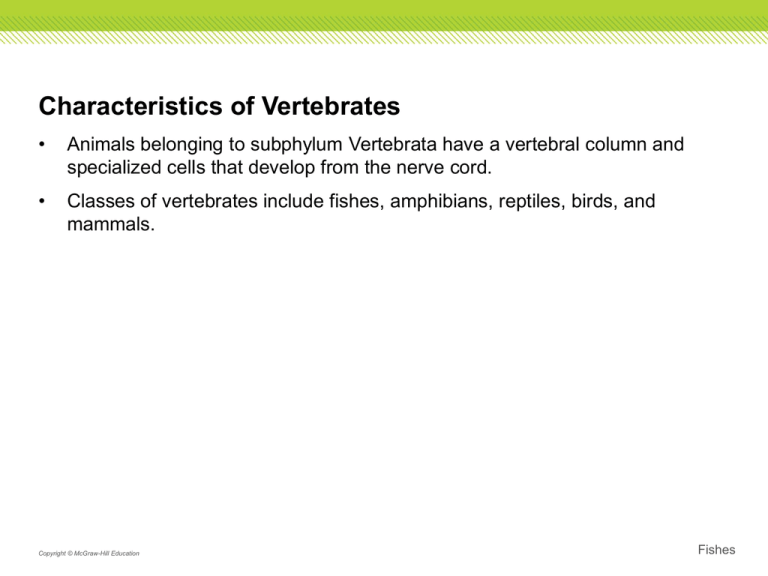Characteristics of Fishes
advertisement

Characteristics of Vertebrates • Animals belonging to subphylum Vertebrata have a vertebral column and specialized cells that develop from the nerve cord. • Classes of vertebrates include fishes, amphibians, reptiles, birds, and mammals. Copyright © McGraw-Hill Education Fishes Characteristics of Vertebrates Vertebral column • The notochord is replaced by a vertebral column that protects and surrounds the dorsal nerve cord. • Made of cartilage – flexible tough material found in skeletons, or bone • The vertebral column functions as a strong, flexible rod that muscles can pull against during swimming or running. Copyright © McGraw-Hill Education Fishes Characteristics of Vertebrates Neural crest • A neural crest is a group of cells that develop from the nerve cord in vertebrates. • Portions of the brain and skull, certain sense organs, and some nerve fibers are some of the structures that develop from the neural crest. Copyright © McGraw-Hill Education Fishes Characteristics of Fishes • Fishes are found in a variety of aquatic habitats including seas, lakes, ponds, streams, and marshes. • Most fishes have vertebral columns, jaws, paired fins, scales, gills, and single-loop blood circulation. Copyright © McGraw-Hill Education Fishes Characteristics of Fishes Jaws • Anterior gill arches evolved into jaws in ancient fishes. • The development of jaws allowed ancient fishes to prey on a larger range of animals. Copyright © McGraw-Hill Education Fishes Characteristics of Fishes Paired fins • A fin is a paddle-shaped structure on a fish or other aquatic animal that is used for balance, steering, and propulsion. • Paired fins reduce the chance of rolling to the side and allow for better steering during swimming. Copyright © McGraw-Hill Education Fishes Characteristics of Fishes Scales • Scales are small, flat, platelike structures near the surface of the skin • Ctenoid scales – made of bone and skin • Cycloid scales – made of bone and skin • Placoid scales – made of toothlike material • Ganoid scales – made of enamel and bone Copyright © McGraw-Hill Education Fishes Characteristics of Fishes Gills • Fishes get oxygen when water that enters their mouths flows across their gills, where oxygen from the water diffuses into the blood. • The flow of blood in the gills is opposite the flow of water across the gills, allowing for more efficient uptake of oxygen • Some fish protect their gills with operculum, a movable flap. Copyright © McGraw-Hill Education Fishes Characteristics of Fishes Circulation • Vertebrates have a closed circulatory system. • In most fishes, the heart consists of two main chambers – the atrium, where the heart receives blood from the body, and the ventricle, where the heart pumps blood to the gills. Copyright © McGraw-Hill Education Fishes Blood Flow in Fish Animation FPO Add link animation from page 824 (figure 8) here. Copyright © McGraw-Hill Education Fishes Characteristics of Fishes Feeding and digestion • Ancient fishes were most likely filter feeders and scavengers. • Most fishes swallow their food whole, passing it through a tube called the esophagus to the stomach, where digestion begins. • Fishes and subsequent vertebrates are unable to synthesize certain amino acids, and must get them from food. Copyright © McGraw-Hill Education Fishes Characteristics of Fishes Excretion • Cellular wastes are filtered from fishes’ blood by the kidneys. • A nephron is a filtering unit within the kidney that helps maintain the salt and water balance of the body and to remove cellular waste products from the blood. Copyright © McGraw-Hill Education Fishes Characteristics of Fishes The brain and senses • Color vision, chemical detection, hearing, and balance are coordinated in the brain. • The lateral line system is a sensory system the allows fish to detect movement in the water, and also helps to keep them upright and balanced. Copyright © McGraw-Hill Education Fishes Characteristics of Fishes Reproduction • The majority of fishes reproduce through external fertilization, but some do have internal fertilization. • Male and female fishes release their gametes near each other in the water in a process called spawning. • Developing embryos get nutrition from the yolk of their eggs. • Many fish produce large numbers of eggs and exhibit little care for their offspring. Copyright © McGraw-Hill Education Fishes Characteristics of Fishes Movement • Most fish have a streamlined shape for moving through water. • Mucus lubricates their body • Have a gas-filled space called a swim bladder that allows a fish to control it’s depth • Fishes move through the water by contracting muscle groups on either side of their bodies. Copyright © McGraw-Hill Education Fishes Review Essential Questions • What are the features of vertebrates that make them different from invertebrates? • What are the characteristics that most fishes have in common? • How are the characteristics of fishes adapted to aquatic life? Vocabulary • • • • cartilage neural crest fin scale Copyright © McGraw-Hill Education • • • • operculum atrium ventricle nephron • lateral line system • spawning • swim bladder Fishes







